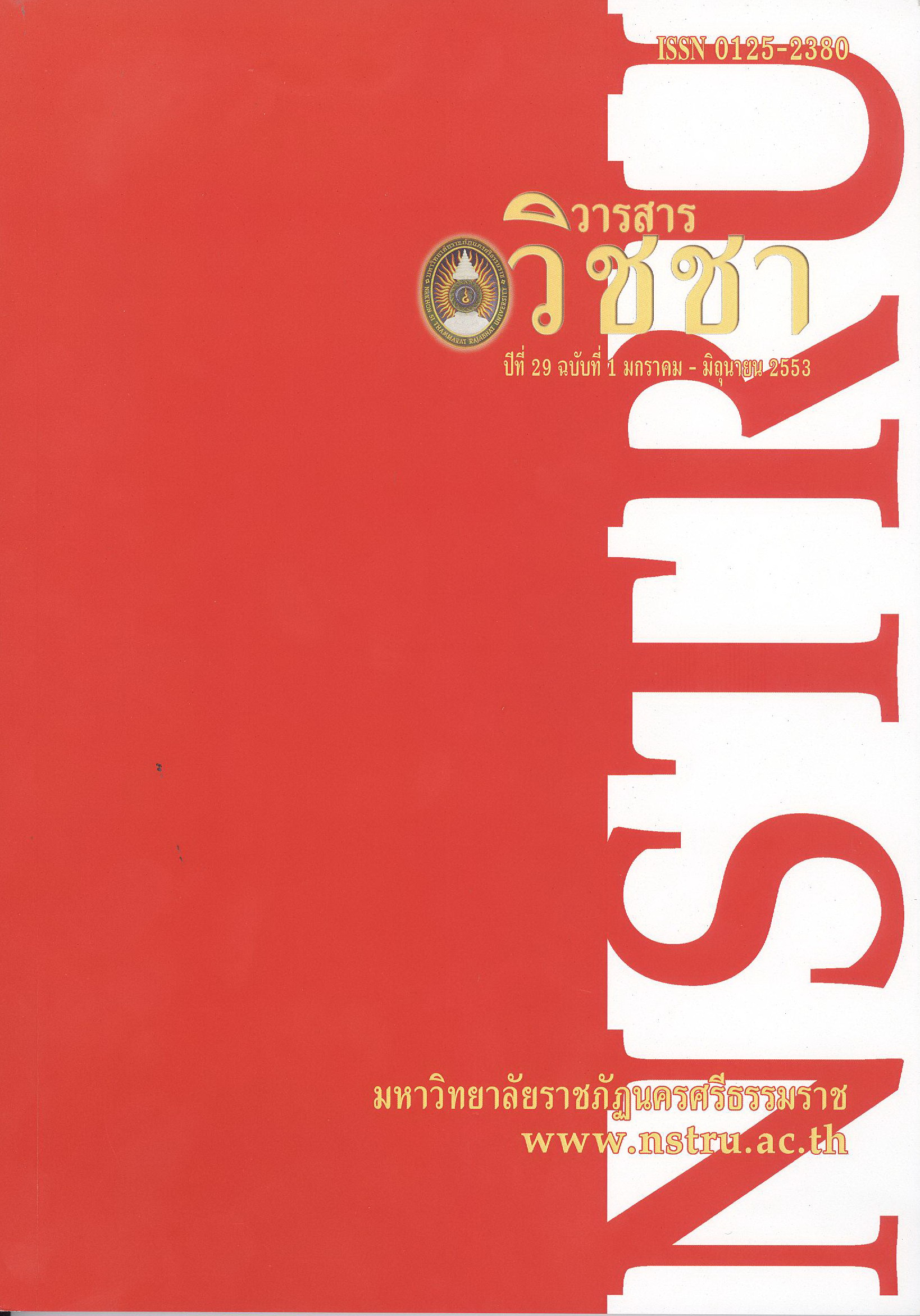การบริหารจัดการน้ำประปาหมู่บ้านของตำบลละอาย อำเภอฉวาง จังหวัดนครศรีธรรมราช
Main Article Content
Abstract
วิธีการศึกษาครั้งนี้ใช้วิธีการวิจัยเชิงปริมาณ (Quantitative Research) ใช้แบบสอบถามเก็บข้อมูลครัวเรือน ในพื้นที่ชุมชนละอายจำนวน 2 หมู่บ้าน โดยใช้แบบสอบถามจำนวน 126 ครัวเรือน ส่วนการวิจัยเชิงคุณภาพ (Qualitative Research) ใช้วิธีอภิปรายกลุ่ม (Focus group) การสัมภาษณ์แบบเจาะลึก (In-depth Interview) และการ สังเกตแบบมีส่วนร่วมและไม่มีส่วนร่วม
ผลการศึกษาพบว่า ชุมชนละอายเป็นชุมชนที่มีความอุดมสมบูรณ์ไปด้วยทรัพยากรธรรมชาติ เพราะมี พื้นที่ติดกับเทือกเขานครศรีธรรมราช ชาวบ้านมีความรู้ในการจัดการทรัพยากรน้ำในรูปแบบต่าง ๆ ได้แก่ ทำนบ เหมือง หนองน้ำ บ่อน้ำ บ่อน้ำบาดาล และคลอง ซึ่งมีคลองเสลาเป็นลำน้ำสายสำคัญทั้งในอดีตและปัจจุบัน การ จัดการน้ำของชุมชนมีความสัมพันธ์กับสภาพทางภูมิศาสตร์และระบบการผลิตของชุมชน นอกจากนี้ยังมีปัจจัย ภายในและปัจจัยภายนอกชุมชนเข้ามามีส่วนในการบริหารจัดการน้ำ
การใช้ประโยชน์และการจัดการทำนบ เหมือง หนองน้ำ มีการใช้ประโยชน์ในการนำน้ำมาใช้เพื่อการทำ นา การทำสวนผลไม้ การจับสัตว์น้ำ และใช้อุปโภคในครัวเรือน ชาวบ้านทั้งในและนอกชุมชนมีสิทธิใช้ประโยชน์ จากแหล่งน้ำดังกล่าว ชาวบ้านจะช่วยกันดูแลรักษาขุดลอกเหมืองเมื่อตื้นเขิน ส่วนทำนบและหนองน้ำเมื่อตื้นเขินจะ มีหน่วยงานภาครัฐเข้ามาทำการขุดลอกให้
การใช้ประโยชน์และการจัดการคลองเสลา ถือว่าเป็นคลองสายหลักของชุมชน มีการใช้ประโยชน์เป็น เส้นทางคมนาคม การทำนา สวนผลไม้ และการจับสัตว์น้ำ ปัจจุบันใช้น้ำเป็นแหล่งน้ำดิบเพื่อผลิตน้ำประปา หมู่บ้านเป็นหลัก
การบริหารจัดการน้ำประปาหมู่บ้านของชุมชนละอาย ได้แบ่งการศึกษาออกเป็น 6 ประเด็น พบว่า ค่าเฉลี่ยและความคิดเห็นของประชาชนด้านบุคคลากร ค่าเฉลี่ย 3.00 ด้านสมาชิกผู้ใช้น้ำ ค่าเฉลี่ย 2.82 ด้านการ วางแผน ค่าเฉลี่ย 2.79 ความคิดเห็นประชาชนด้านกฎระเบียบและข้อบังคับ ค่าเฉลี่ย 2.73 ความคิดเห็นของ ประชาชนด้านการเงิน ค่าเฉลี่ย 2.61 ความคิดเห็นของประชาชนด้านวัสดุอุปกรณ์ ค่าเฉลี่ย 2.51
ส่วนปัญหาของระบบประปาหมู่บ้านของตำบลละอาย ได้แก่ ปัญหาปริมาณน้ำที่ใช้ในการผลิตน้ำประปา ปัญหาด้านคุณภาพน้ำ และปัญหาการบริหารจัดการประปาหมู่บ้าน
ข้อเสนอแนะชาวบ้านควรมีการจัดตั้งกลุ่มและบริหารจัดการระบบประปาหมู่บ้านเอง ควรมีการจัดการกับ แหล่งน้ำที่นำมาใช้ในการผลิตน้ำประปาหมู่บ้าน เพื่อให้มีน้ำมาใช้ในการผลิตน้ำประปาในทุกฤดูกาลได้อย่าง เพียงพอและมีคุณภาพที่ดี หน่วยงานที่เกี่ยวข้องกับระบบปาควรเข้ามาดูแล ซ่อมแซมอุปกรณ์และเครื่องมือที่ใช้ใน การผลิตน้ำประปาหมู่บ้าน เพื่อให้การผลิตน้ำประปาหมู่บ้านมีประสิทธิภาพ เจ้าหน้าที่จากหน่วยงานที่เกี่ยวข้อง ควรเข้ามาวิเคราะห์คุณภาพน้ำประปาอย่างต่อเนื่อง เพื่อทำให้ชาวบ้านได้ใช้น้ำประปาที่มีคุณภาพและส่งผลดีต่อ สุขภาพอนามัยของชาวบ้านในชุมชน
Water Supply Management in Villages of La-ai Sub-District, Chawang District, Nakhon Si Thammarat Province
This research is concerned with the management of main (municipal) water supply in villages of La-ai sub-district, Chawang district, Nakhon Si Thammarat province. The aim of this study is to study the knowledge and management of the water supply in villages of La-ai sub-district, Chawang district, Nakhon Si Thammarat province.
The quantitative research methods used in this research were in the form of questionnaires, which were sent to 126 households in communal areas of 2 villages of La-ai sub-district. Qualitative research used included focus groups, in-depth interviews, and observation with and without participation.
The results of the study found that La-ai community is a community with an abundance of natural resources. The area is adjacent to the mountains of Nakhon Si Thammarat, and owing to this the villagers have acquired knowledge of various water resource management techniques, including dams, mines, marshes, [natural] wells and artesian wells, and canals. One canal in the community, the Se-la canal, is an important waterway now, as it was in the past. Community water management is related to geographical conditions and systems of production used in the community. Also, there are other internal and external factors which play a part in water management.
Utilisation and management of dams, mines and marshes: Dams, mines and marshes are used to channel water for use in rice and orchard farming, catching aquatic creatures, and household consumption. Villagers from inside and outside of the community all have a right to use water from the sources mentioned. Villagers work together to maintain and dredge the mines when they become shallow. When wells or marshes become shallow, dredging is conducted by state agencies.
Utilisation and management of Se-la canal: Se-la canal is considered the main canal of the community, it is used for communications, rice and orchard farming, and catching aquatic creatures. Currently it is the main source of untreated water used to produce the main water supply provided to the villages.
The study of the management of the main water supply of villages in La-ai community can be divided into 6 points. It was found that the opinions of the population concerning personnel had an average level of 3.00. Of those who belonged to the group of water users, the average was 2.82. For planning, the average was 2.79. For the opinions of the population concerning regulations and statutes, the average was 2.73. For the opinions of the population concerning finance, the average was 2.61. For the opinions of the population concerning materials and equipment, the average was 2.51.
The problems of the main water supply system in the villages of La-ai sub-district concerned the volume of water used in production of water for the main supply, the quality of the water, and management of the main water supply for the villages.
Recommendations suggested are for the villagers to establish groups to manage the water systems themselves. There should be management of the water sources used in the production of a main water supply for the villages, which would allow for water to be used in the production of a sufficient supply of good quality water in all seasons. Relevant agencies should take care of repairs, equipment, and tools used in the production of a village water supply. To ensure efficiency, officials from relevant agencies should analyse the quality of the water supply regularly. This will ensure that villagers use good quality water which is beneficial to health and hygiene.
Article Details
เนื้อหาและข้อมูลในบทความที่ลงตีพิมพ์ในวารสารวิชชา มหาวิทยาลัยราชภัฏนครศรีธรรมราช ถือเป็นข้อคิดเห็นและความรับผิดชอบของผู้เขียนบทความโดยตรง ซึ่งกองบรรณาธิการวารสารไม่จำเป็นต้องเห็นด้วยหรือร่วมรับผิดชอบใด ๆ
บทความ ข้อมูล เนื้อหา รูปภาพ ฯลฯ ที่ได้รับการตีพิมพ์ในวารสารวิชชา มหาวิทยาลัยราชภัฏนครศรีธรรมราช ถือเป็นลิขสิทธ์ของวารสารวิชชา มหาวิทยาลัยราชภัฏนครศรีธรรมราช หากบุคคลหรือหน่วยงานใดต้องการนำข้อมูลทั้งหมดหรือส่วนหนึ่งส่วนใดไปเผยแพร่ต่อหรือเพื่อการกระทำการใด ๆ จะต้องได้รับอนุญาตเป็นลายลักษณ์อักษรจากวารสารวิชชา มหาวิทยาลัยราชภัฏนครศรีธรรมราชก่อนเท่านั้น
The content and information in the article published in Wichcha journal Nakhon Si Thammarat Rajabhat University, It is the opinion and responsibility of the author of the article. The editorial journals do not need to agree. Or share any responsibility.

